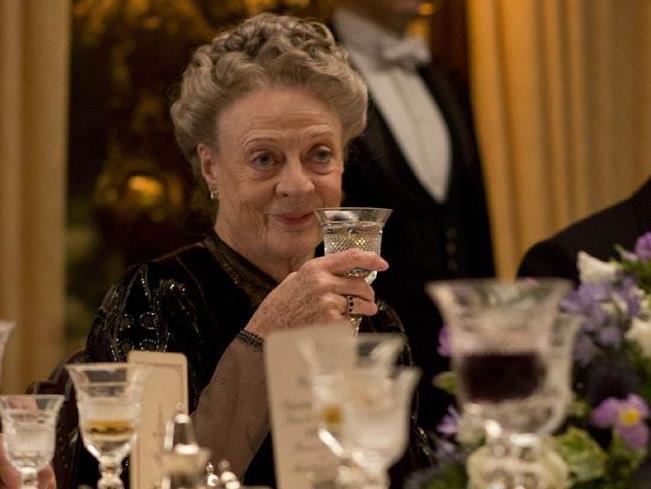Smile sweetly and answer sharply like Lady Violet in Downton Abbey
The arts are important to more and more people. As an industry, the arts employs more people than mining. Study after study connects art with health and innovation and the economy. And yet, there are still too many lazy responses to the arts in the mass-market media.
Call their bluff
A couple of years ago,one of the ABC regional stations hopped on the bandwagon. Laura Woodward’s Concentric (2012) had just been commissioned for the Western Highway and unveiled by Horsham Rural City Council. The local ABC’s first response was to take a highly misleading photograph of the work and post it on their Facebook, with language that deliberately incited all of the usual waste-of-money responses, and succeeded in lighting up their talkback radio panel. The work had been photographed from the back and the inside so as to highlight the bolts that secure the metal sculpture to the ground – as opposed to photographing it from the highway as a work of art designed to be viewed in motion and at speed.
This was bad as photographing the Mona Lisa from the back and ridiculing its hanging wires, as I told a journalist on the day. The very next day, the post and all of the comments had been deleted from their Facebook page.
Clearly, it was much easier for that journalist to trot out the outrage template rather than think about the purpose of highway sculpture – but equally clearly fighting back worked.

Laura Woodward, Concentric
Smart answers for silly statementsSo what do you do when someone says that art is a waste of money? How best to address that resentment? Here are some common attacks and some ideas for how you can respond.
There are more important things for governments to spend taxpayers’ money on.
Here’s one you’ll often be faced with at parties or family gatherings where it’s not just a crowd of makers. My typical response to that one is a series of questions, spoken slowly, leaving plenty of time for response: What’s the most important thing in your life? Why are you alive? What makes life worth living? What’s the most important, the most visionary thing that government could do with your taxes? What would it take to achieve that? I always try to use this one as a conversation starter and not a conversation ender.
The local hospital needs a new bed so we shouldn’t be wasting money on a festival.
Leave aside the fact that the arts and health budgets have nothing to do with one another, and focus on what that local hospital bed means. People who lead active, connected lives remain healthier longer. And what’s more compelling: the arts is actually good for your health.
Study after study has shown this. Here’s just a handful of them, with plenty of handy come-backs for the hospital bed argument:
- Experiencing art strengthens the immune system. Research in 2015 by psychologists at University of California, Berkeley looked at the experience of awe when experiencing works of art. They found that this stimulates more cytokines, the chemicals that redirect cells to where they’re most needed in the body to fight infection. UC Berkeley’s Dacher Keltner, a co-author of the study, concluded: ’Losing oneself in music, beholding art – has a direct influence upon health and life expectancy.’
- Looking at art makes the brain feel rewarded, satisfying parts of the brain that might instead become associated with more destructive forms of addiction such as drugs or gambling. As distinct from positive responses to aesthetic preferences, researchers at Emory University School of Medicine in 2011 focused on other parts of the brain that guide behaviour, and found that looking at works of art also stimulates the parts of the brain that make decisions in volatile situations.
- The brain initiates introspection and self-referential thought when experiencing powerful works of art. At the NYU Centre for Brain Imaging in 2014, researchers found that the brain’s medial prefrontal cortex, a sophisticated region usually inactive when we’re doing our everyday thing, is activated by powerful art. In this way, art helps train the mind to engage in thinking that’s in-depth, rigorous and personal.
Attending a festival does wonders for your physical and mental health and well-being. Especially for regional communities, a festival is a focal point for people who’ve travelled great distances; for artists who work in isolation; for communities who don’t see themselves addressed or represented anywhere else in the public space. Festivals keep people out of hospital beds.
Highway sculptures are a waste of money – fix the potholes instead.
That’s a favourite. Would you ask an architect to fix your leaking tap? It can be hard to explain to people that these are very different processes; arts money doesn’t fund road repair any more than it funds hospital beds. Across regional landscapes increasingly obliterated by roads, ramps and overpasses, highway sculpture serves a very important purpose. It reintroduces a sense of place. It punctuates long journeys with recognisable forms. It reminds you that no matter how seamlessly your car can slice through country, surrounding that road there are people and communities and histories, of which the sculpture is just one expression. Far from presenting a dangerous distraction, highway sculpture reinserts reference points along extended journeys that break them into finite intervals of time – reminding you to take a break, rather than stay on highways designed to fabricate the experience of a seamless journey… and fast lull you into a stupor.
I know you’ve heard a million of these. I’ve only scratched the surface! What are your favourite clangers? Add them below, and let’s all see how we might respond.





